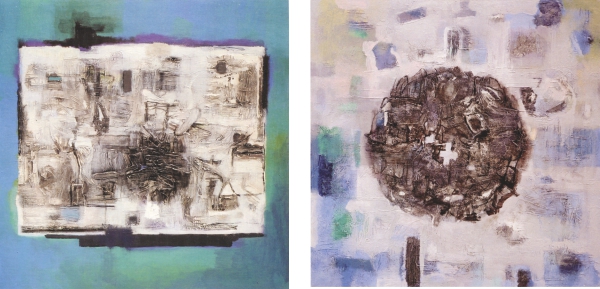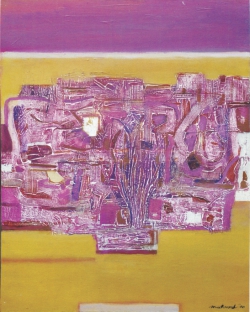| Home - Back Issues - The Team - Contact Us |
 |
| Volume 12 |Issue 07| February 15, 2013 | |
|
|
Art
The Cry of Abstraction Fayza Haq Mahmudul Haque's solo exhibit which ends on 21st February, continues his usual style and theme which relies heavily on nature. This time, however, his creations have more colour, harmony and vitality than his displays seen before. They are also more abstract. The artist says that he finds no great difference in reality and abstraction. He says that when he paints a flower, he can capture the colour and lines of its fleshy petals—but if he fails to capture the essence of its scent, he has not reproduced the entire beauty of the flower. He has freedom to see what he wishes to—a tree might appear uninteresting for some, while he, an artist has the right to see Nature as he wishes to. No one has the right to dictate presentation of his vision, says the master artist. It is for the painter and print maker to represent the full moon or the crescent shape in the sky, he says. The ordinary art lover wishes to see familiar elements in the art work. There then grows a gap between the artist and the viewer. With time this difference in vision may ease out—and the viewer may accept the modern representation.
Asked if his trips to Paris, France and the US etc. have helped him in his work as an artist, Mahmudul Haque says that there is no doubt that his trips overseas have broadened his horizon. The artist says that he had a simple origin, and came from Sri Phal Tala village, Bagerhat. He would often go to different places to see museums and galleries: exchanging ideas with people from overseas was an experience which cannot be ignored. Nature in Bangladesh is certainly different from that in Japan and the US or even UK. He feels that the experience that he acquired has helped him greatly by enriching his viewpoint. Haque loves the leaves, trees, branches and flower buds. Out of these and raindrops and sunshine he has created the abstractions in green, yellow and other earthy hues. Asked where he felt that the local people were most warm and understanding.
Mahmudul Haque says that he likes the experience of mixing and blending with people from overseas, but that to be frank, to him there is nothing like the cosiness of home. He says that it is homeland where he has spent his youth where he is mostly at ease and most wanted, praised and loved. Among his guides and teachers he says Picasso was his favourite painter for a long time, when he made semi-realistic paintings. The colours and lines may not have been those of the Spaniard but his muse was certainly the “Guernica” genius. Later on, he says, it was Henri Matisse and Miro and Paul Klee who fascinated him. Hashem Khan was his first teacher and later he learnt from Kazi Abdul Baset and the person who taught him most of all was Mohammed Kibria. They resided in the same hostel, and even in his holidays he did not go home, but tried to learn from this great master. There was a great camaraderie between teacher and student in this manner. They confided in each other till Mohmmad Kibria's last days, says Mahmudul Haque. The artist claims that in this manner he gained the icon's affection as no one else did. Later on, different artists like Aminul Islam or Qayyum Chowdury, Murtaja Baseer, and Rashid Chowdhury played important roles in his career. Haque has various presentations of Nature in different stages such “The dance of life” and “Foliage and life”. He has put his ideas on canvas so that the entire horizon is brought in. He tried to bring in the “rhythm and charm” in the squares and oblongs of his canvases. Even when he depicted rivers, he got horizontal lines. These paintings, he says, are doors and windows to drink in the beauty of Nature, its leaves, tress flowers and birds. He feels that art in Bangladesh is still not understood. The obvious and apparent beautiful images – such as the do-tara, water-lilies and boats or an attractive female form is not all there is to the beauty of Bangladesh. He says that his work is the simplification of images. He sees colours through his own unique vision. The texture changes from one kaleidoscopic rectangle to another, Although his colours are fluid his rectangles make his paintings somewhat stylised. One does get the impression of banana leaves and stones. His collages also appear like colourful kanthas. His horizontal lines and images, balanced with the vertical ones bring in the artist's romantic past.
|
||||||||
Copyright
(R) thedailystar.net 2013 |
|||||||||


